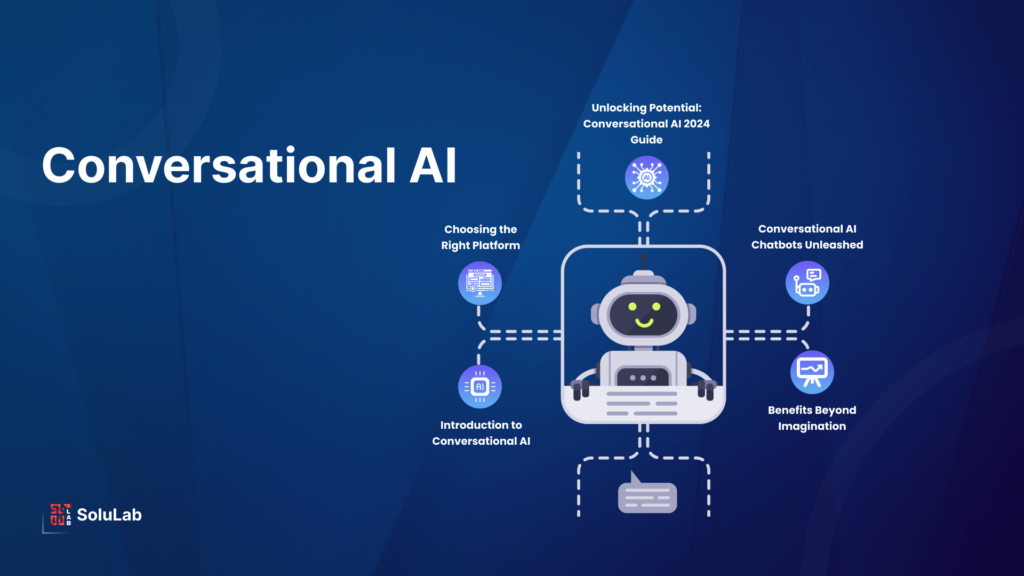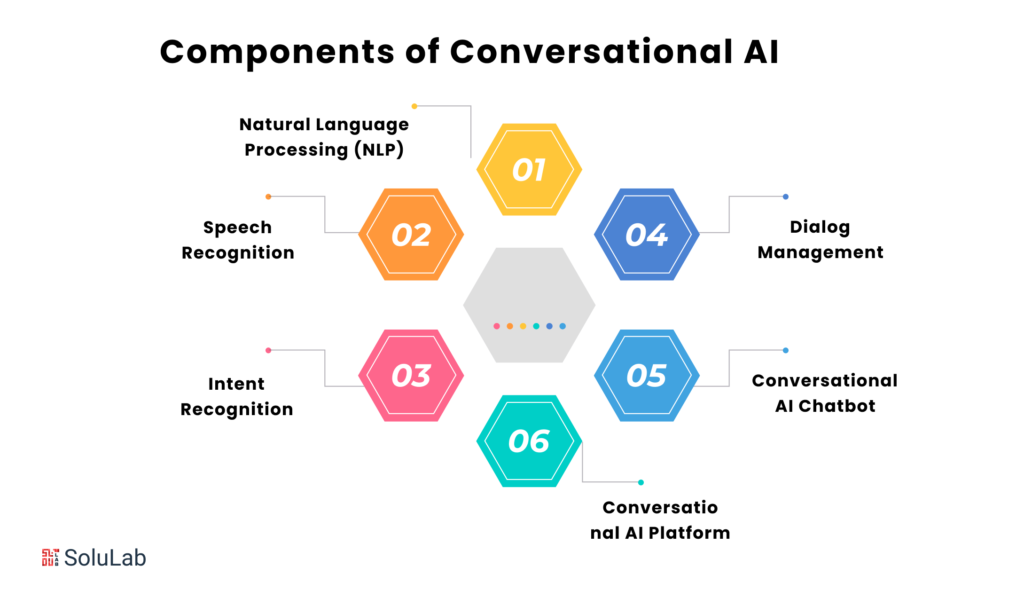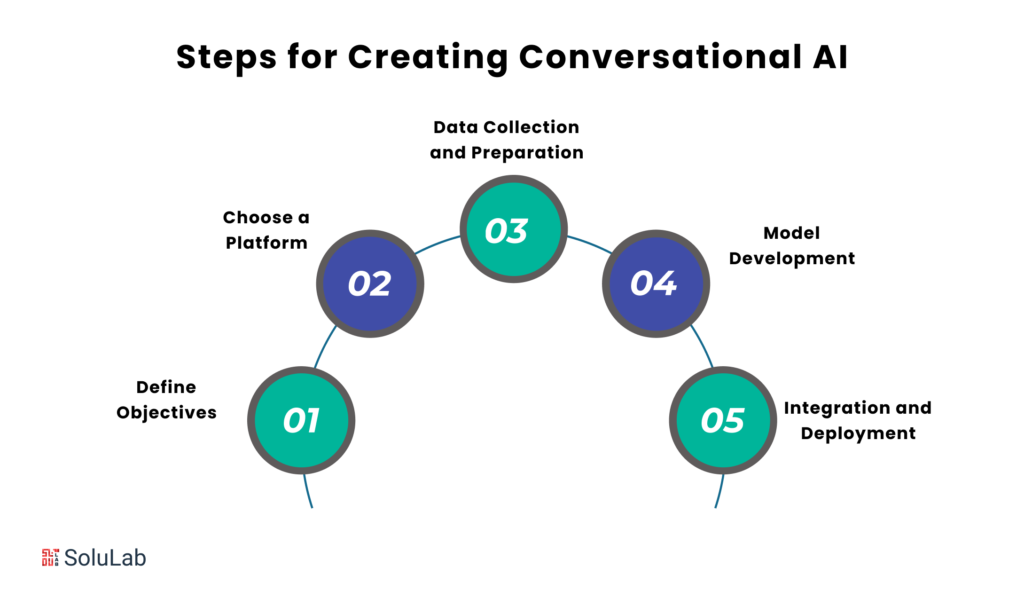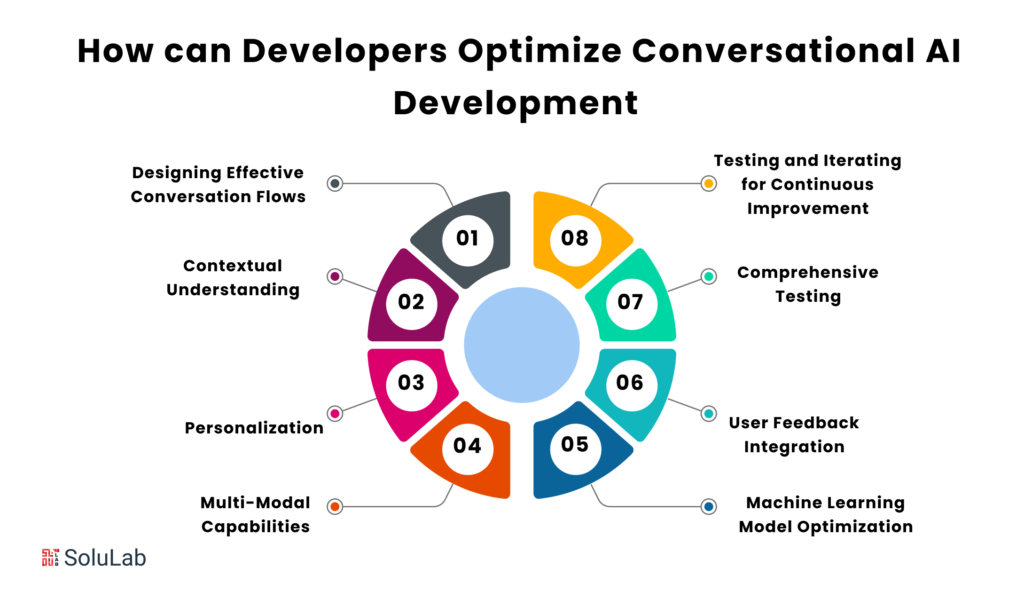
Conversational AI, a groundbreaking technological paradigm, represents the synthesis of artificial intelligence and natural language processing to enable human-like interactions between computers and users. At its core, Conversational AI seeks to imbue machines with the ability to understand, interpret, and conversationally respond to human language. This transformative technology has rapidly evolved, ushering in a new era of human-computer interaction.
As we look ahead to 2025, the importance of Conversational AI is poised to reach unprecedented heights. Businesses, organizations, and industries increasingly recognize the strategic significance of deploying Conversational AI platforms. This technology enhances user experience and streamlines customer service, leading to increased efficiency and customer satisfaction. The ability of Conversational AI to handle complex queries, personalize interactions, and provide real-time assistance positions it as a cornerstone in the digital transformation landscape.
The future of Conversational AI has been marked by continuous innovation and rapid growth. From its nascent stages, where basic chatbots handled simple queries, to the present era where sophisticated conversational AI platforms employ natural language understanding and generation, the journey has been remarkable. This growth can be attributed to advancements in machine learning, increased computational power, and the vast datasets that have refined Conversational AI algorithms.
What is Conversational AI?
Conversational AI, short for Conversational Artificial Intelligence, is a cutting-edge technology designed to enhance human-machine interaction by enabling computers to understand, interpret, and respond to natural language inputs. In essence, it strives to make interactions with machines more conversational, mimicking the way humans communicate.
At its core, Conversational AI utilizes advanced natural language processing (NLP) algorithms and machine learning techniques to comprehend user inputs, such as spoken or written language, and generate contextually relevant responses. This transformative technology has gained immense traction across various industries, driven by the growing demand for seamless and efficient communication between users and machines.
A key component of Conversational AI is the conversational AI platform, which serves as the foundation for developing and deploying interactive chatbots. These platforms leverage sophisticated algorithms to understand user intent, extract meaningful information, and craft responses that mirror natural conversation. The flexibility of conversational AI platforms allows organizations to create custom chatbots tailored to their specific needs and industries.
Why Does Your Business Need Conversational AI in 2023?
Implementing a robust conversational AI platform is not just a trend; it’s a strategic imperative. These platforms empower businesses to automate routine tasks, offer 24/7 customer support, and gather valuable insights through data analytics. The benefits of conversational AI are multifold, making it an invaluable asset for businesses in 2023.
A. Benefits of Conversational AI
-
Enhanced Customer Experience
Conversational AI chatbots offer instant and personalized responses, enhancing the overall customer experience. This leads to increased customer satisfaction and loyalty.
-
Operational Efficiency
By automating repetitive tasks, conversational AI streamlines operations, allowing businesses to allocate resources more effectively and focus on strategic initiatives.
-
24/7 Availability
Conversational AI operates around the clock, providing continuous customer support and engagement. This ensures businesses are always accessible to their global audience.
-
Data-Driven Insights
Conversational AI platforms gather and analyze vast amounts of data from customer interactions. These insights can be utilized to understand customer behavior, preferences, and trends, enabling data-driven decision-making.
-
Cost Savings
Automating customer support and routine tasks with conversational AI reduces the need for human intervention, leading to significant cost savings in the long run.
B. Conversational AI Chatbot: Your Business Ally
A key component of conversational AI, chatbots are digital assistants that facilitate real-time conversations. These intelligent bots are capable of understanding user intent, answering queries, and even completing transactions. The versatility of conversational AI chatbots makes them invaluable across various industries, from e-commerce and healthcare to finance and beyond.
What are the Components of Conversational AI?

Conversational AI, an evolving field within artificial intelligence (AI), focuses on enhancing human-computer interaction through natural and interactive conversation. Let’s explore the fundamental components of Conversational AI without delving into cutting-edge technologies.
-
Natural Language Processing (NLP)
Foundational to Conversational AI, NLP enables machines to understand, interpret, and generate human-like language. This component ensures that the system comprehends user inputs, facilitating seamless and intuitive interactions.
-
Speech Recognition
Conversational AI often incorporates speech recognition technology, allowing systems to convert spoken words into text. This feature enhances accessibility and supports communication in scenarios where typing may be impractical.
-
Intent Recognition
Understanding user intent is critical for effective communication. Conversational AI platforms utilize intent recognition algorithms to decipher the purpose behind user queries, ensuring accurate and relevant responses.
-
Dialog Management
Dialog management is crucial for maintaining context and managing the flow of a conversation. Conversational AI platforms use this component to track ongoing interactions, ensuring coherent and meaningful conversations.
-
Conversational AI Chatbot
Chatbots serve as virtual assistants within Conversational AI, engaging users in conversations. These bots leverage NLP, speech recognition, and intent recognition to understand user queries, formulate responses, and execute tasks, offering personalized and efficient user experiences.
-
Conversational AI Platform
A central component, the Conversational AI platform serves as the infrastructure integrating various elements. These platforms facilitate the development, deployment, and management of conversational applications, simplifying the implementation and scaling of Conversational AI solutions.
What are the Challenges of conversational AI technologies?
Conversational AI is reshaping the way we interact with machines, presenting a host of opportunities and challenges. This article explores the hurdles associated with Conversational AI, shedding light on its essence, benefits, and the pivotal role of conversational AI platforms.
It involves technologies that facilitate natural language communication between humans and machines. It encompasses applications such as conversational AI platforms and chatbots, aiming to enable machines to comprehend and respond to human language in a way that mirrors authentic conversation.
A. Challenges in Conversational AI
-
Natural Language Understanding (NLU)
The ongoing challenge lies in developing a robust NLU that allows machines to grasp context, nuances, and user intent accurately.
Context RetentionSustaining context across multiple turns in a conversation proves challenging, requiring seamless recall of previous interactions for coherent responses.
-
Handling Ambiguity
The inherent ambiguity of human language poses a hurdle, demanding the ability to decipher ambiguous queries and provide precise responses.
-
Integration Complexity
Implementing Conversational AI within existing systems is complex, requiring seamless integration with various databases, applications, and platforms.
-
Personalization Challenges
Striking the right balance between personalization and privacy is a challenge, as Conversational AI aims to tailor responses to individual user preferences.
B. The Role of Conversational AI Platforms
Conversational AI platforms serve as the backbone, providing a framework for designing, deploying, and managing conversational agents. These platforms integrate natural language processing, machine learning, and analytics to refine performance continually.
The journey of Conversational AI, while filled with potential, is not without its challenges. Overcoming these obstacles will drive the technology into new frontiers, enriching digital experiences and redefining human-machine interaction. As Conversational AI evolves, it will undoubtedly play a pivotal role in shaping the future of communication with machines.
How to Create Conversational AI?

In the ever-evolving world of artificial intelligence, Conversational AI stands out as a game-changer, reshaping how businesses interact with users. This guide will take you through the process of creating Conversational AI, explaining what it is, the importance of conversational AI platforms, and the numerous benefits tied to using conversational AI chatbots.
To create Conversational AI, follow these steps:
-
Define Objectives
Clearly outline your goals for the Conversational AI system. Whether it’s for customer support, lead generation, or providing information, having a clear purpose will guide the development process.
-
Choose a Platform
Pick a conversational AI platform that suits your project needs. Popular platforms like Dialogflow, Microsoft Bot Framework, and Rasa offer a variety of tools for building, training, and deploying enterprise chatbots.
-
Data Collection and Preparation
Gather relevant data to train the conversational model. This data should cover a range of user inputs and scenarios to ensure the AI system is versatile and robust.
-
Model Development
Develop the conversational model using machine learning techniques. Train the model on your dataset, fine-tuning it to understand user intents and generate appropriate responses.
-
Integration and Deployment
Integrate the Conversational AI system into your chosen communication channels, such as websites, mobile apps, or messaging platforms. Deploy the model and keep an eye on its performance.
How does Conversational UX Design Enhance User Engagement and Personalization?
Conversational UX Design has emerged as a critical aspect of user interaction, revolutionizing the way individuals engage with technology. In the realm of Conversational AI, user experience (UX) holds paramount importance.
A. Importance of User Experience (UX)
-
Creating User-Friendly Conversational Interfaces
Conversational AI, powered by natural language processing, strives to emulate human-like interactions. The significance lies in crafting interfaces that users find intuitive and comfortable to navigate. User-friendly interfaces enhance engagement and facilitate seamless communication.
-
Design Principles for Effective Communication
Designing effective Conversational UX involves adhering to principles that govern clear, concise, and context-aware communication. Ensuring that the interface understands user intent, provides relevant responses, and maintains a coherent conversation contributes to a positive UX.
B. Personalization in Conversational UX
-
Tailoring Experiences Based on User Preferences
Personalization is a key driver of Conversational UX. By understanding user preferences, Conversational AI platforms can tailor responses and suggestions, creating a more individualized experience. This not only enhances user satisfaction but also strengthens user-brand relationships.
-
Utilizing User Data for Personalized Interactions
Leveraging user data responsibly enables Conversational AI to offer personalized interactions. By analyzing past interactions and learning from user behavior, these systems can adapt and improve, delivering more accurate and relevant responses over time.
C. Multimodal Interfaces
-
Integrating Text, Voice, and Visuals
Conversational UX design goes beyond text-based interactions, incorporating voice and visual elements for a richer experience. This integration allows users to communicate through their preferred medium, making the interaction more versatile and inclusive.
-
Providing a Seamless User Experience Across Channels
A hallmark of advanced Conversational UX is the ability to seamlessly transition between channels. Whether users prefer text, voice, or visual interfaces, the design should ensure a cohesive and consistent experience, fostering user confidence and satisfaction.
How can Developers Optimize Conversational AI Development Through Effective Conversation Flow Design and Continuous Testing?

In the rapidly evolving landscape of artificial intelligence, Conversational AI has emerged as a transformative technology, offering interactive and human-like interactions between machines and users. To harness the full potential of Conversational AI, developers must adhere to best practices throughout the development process. In this article, we explore two crucial aspects: designing effective conversation flows and testing for continuous improvement.
-
Designing Effective Conversation Flows
Creating a seamless and engaging user experience begins with thoughtful conversation flow design. Understanding the context and user intent is paramount.
-
Contextual Understanding
Conversational AI platforms should be equipped to comprehend the context of a conversation. Utilize natural language processing (NLP) algorithms to interpret user input accurately. This ensures that the AI responds appropriately, maintaining a coherent and contextually relevant dialogue.
-
Personalization
Tailor conversations to individual users by leveraging user data. Incorporate user preferences, history, and behavior to provide personalized responses. This enhances the user experience and fosters a sense of connection with the AI.
-
Multi-Modal Capabilities
Extend beyond text-based interactions. Incorporate voice, images, and other modalities to create a more dynamic and versatile conversational experience. Ensure that the AI platform can seamlessly transition between different modes of communication.
-
Testing and Iterating for Continuous Improvement
The journey of Conversational AI development is an ongoing process that requires meticulous testing and continuous refinement. This phase is critical to ensuring the effectiveness and reliability of the conversational system.
-
Comprehensive Testing
Rigorous testing is essential to identify and rectify potential issues. Conduct thorough tests on various devices, platforms, and browsers to ensure compatibility. Evaluate the AI’s ability to handle different input variations and scenarios.
-
User Feedback Integration
Actively seek user feedback to understand their experience. Integrate feedback loops into the development process to identify areas for improvement. Address common user concerns and refine the conversational flow accordingly.
-
Machine Learning Model Optimization
Continuously update and optimize machine learning models powering the Conversational AI. Regularly retrain models with new data to enhance accuracy and stay abreast of evolving language patterns.
Conclusion
In conclusion, as we embark on the journey into 2025, Conversational AI stands at the forefront of technological innovation, reshaping the way we interact with digital systems. This comprehensive guide has delved into the intricacies of Conversational AI, providing valuable insights into its applications, benefits, and potential for transformative change.
One prominent player in this arena is SoluLab, a trailblazer in AI development services. Their expertise in crafting AI-powered solutions, including cutting-edge chatbots, positions them as a key ally for businesses aspiring to stay ahead in the rapidly evolving digital landscape.
By choosing to hire AI developers linked with SoluLab, organizations can unlock a world of possibilities. The synergy between skilled developers and SoluLab’s innovative solutions ensures the seamless integration of Conversational AI, fostering enhanced user experiences and driving operational efficiency.
In the realm of Conversational AI for 2025, the collaboration between forward-thinking businesses, talented AI developers, and pioneering companies like SoluLab holds the key to unlocking new dimensions of success. As we navigate the future, the evolution of Conversational AI promises to be an exciting journey, with SoluLab leading the way in shaping the digital interactions of tomorrow.
FAQs
1. What is Conversational AI, and how does it differ from traditional AI?
Conversational AI refers to the use of artificial intelligence (AI) in creating natural and interactive conversations between computers and humans. Unlike traditional AI, Conversational AI emphasizes communication through chatbots, virtual assistants, and other language-driven interfaces.
2. How can businesses benefit from implementing Conversational AI in 2025?
Businesses can leverage Conversational AI to enhance customer engagement, streamline customer support, and automate routine tasks. The technology helps in providing personalized interactions, improving user satisfaction, and increasing operational efficiency.
3. Why should companies consider hiring AI developers for Conversational AI projects?
Hiring AI developers is crucial for creating robust and customized Conversational AI solutions. These professionals possess the expertise to design, implement, and optimize AI chatbots that align with specific business needs and industry requirements.
4. What are the key features of AI-powered chatbots?
AI-powered chatbots are equipped with natural language processing (NLP) capabilities, enabling them to understand and respond to user queries in a human-like manner. Additionally, these chatbots can learn and adapt through machine learning algorithms, improving their performance over time.
5. How can businesses ensure the security of Conversational AI systems?
Implementing secure protocols and encryption mechanisms is vital for safeguarding Conversational AI systems. Regular security audits and updates, along with data anonymization, contribute to protecting sensitive information exchanged during conversations.
6. Is it possible to integrate Conversational AI with existing business applications?
Yes, Conversational AI can be seamlessly integrated with existing business applications, CRM systems, and other software solutions. This integration enhances workflow efficiency and ensures a unified user experience across different platforms.






